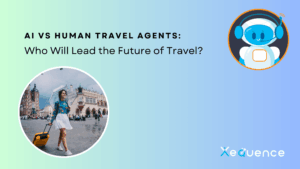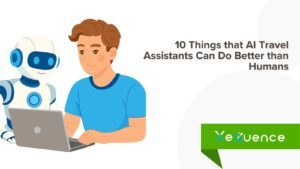- Home
- Artificial Intelligence
- Exploring Generative AI’s Creative Potential
Exploring Generative AI’s Creative Potential
- February 9, 2024
- XequenceAI
- Artificial Intelligence, Gen AI, Hotel Management

Generative AI’s Evolutionary Journey and Use Cases
Gen AI is a kind of artificial intelligence that is ideal to create contents including photos, audio, texts, and videos. They identify inherent patterns in current data and do this work. Enterprises use it to create new and distinct outputs. Introduced in 1960, this technology has become a mainstream working tool for several sectors. With the advancement of the technological world, this technology has the immense capacity to generate impressively accurate audio, images, and movies of real humans. But yes, it can only replicate, match, or remix patterns to produce comparable results. You can use it to provide unique and personalized answers to customers.
AI development timeline
1956: The term ARTIFICIAL INTELLIGENCE was first used in Dartmouth Conference by John McCarthy. It was considered as the event of the birth of AI in hotel industry, which could mimic human intelligence.
1950 to 1960: Symbolic AI – Early AI research is an approach that involves the use of rules and symbols for solving problems. It is focused on GOFAI, or Good Old-Fashioned AI.
1960 to 1970: MYCIN was developed in the 1970s. It was a medical diagnosis expert system which was designed to mimic the decision-making of human experts in specific domains.
1980-1990: AI Winter and Emergence of Machine Learning is an approach came into existence in the early 1980. It was characterized by reduced funding and interest.
1990 to 2000: Machine Learning Resurgence is a subfield of AI focused on algorithms that can learn from data through digital concierge. Neural Networks and Support Vector Machines are the notable innovations in this way. Practical applications of artificial intelligence, such as recommendation systems and spam filters.
2000 to Present: A subfield of machine learning, Deep Learning has become a dominant force in the world of artificial intelligence. This technology has contributed a lot to advancements in the field of natural language processing, computer vision, and speech recognition.
How Does Generative AI Work?
As these are built on deep learning models, generative AI can learn to detect structures and patterns in data. Hence, these can generate new data that is similar to the original. This pre-programmed computing model uses massive amounts of data for learning the techniques of creating new material. It can create Text, Images, Videos, Code, Data, 3D renderings, Music, Speech, and Product designs.
What are the use cases of Generative AI?
Content creation: Content creation has become much easier with the use of Generative AI. It allows individuals to use natural language in order to define the output by input prompts to the AI.
Product design: Companies use this Gen AI for efficient product design. You will be amazed to know that the AI chatbots brainstorm ideas for products and bring out effective solutions. Hence, businesses are creating innovative products to improve existing concepts.
Cybersecurity: As it is used for helping them test networks, this technology has become a popular technology among the security specialists. With its use, network administrators can create synthetic data to simulate network attacks and find security vulnerabilities.
Research assistance: Gen AI is also effective in helping physicians and medical researchers from different industries do their work. It is used to develop new molecular structures.
Art work creation: Artificial Intelligence also helps designers and artists come up with innovative ideas for creating art works. The art generator tools are based on specific artists, art styles, and scenarios. Also, it helps the artists streamline typical art tasks.
What are the key benefits of Generative AI?
- It can reduce the effort of responding to emails.
- It is ideal to automate the manual process of writing content.
- It can improve the response rate to specific technical queries.
- It can enhance responses to specific technical inquiries with more accuracy and detail.
- It is ideal to condense complex information into a coherent and concise narrative.
- It can by automate the process and streamline the manual task of content creation
- It can minimize the effort required to respond to emails.
- It is ideal to simplify content creation in a particular style.
- It creates realistic representations of people.
Generative AI vs. predictive AI vs. conversational AI
Predictive AI forecasts outcomes by using patterns in historical data. It can classify events and actionable insights. However, conversational AI helps chatbots, virtual assistants, and customer service apps to engage and interact with humans. This type of artificial intelligence uses techniques from NLP and machine learning for language understanding and providing human-like text or speech responses.
The final thoughts
In addition to the areas we have mentioned above, there are a lot more benefits to this version of artificial intelligence. As it allows researchers to develop novel drug ideas and understand the protein structure of molecules, AI automation has a significant benefit on the healthcare system. Generative AI also helps hospitals generate synthetic patient data from tests. The doctors can determine if a drug has a chance before starting human trials. It is also ideal to help businesses streamline processes through the automation of tasks. Therefore, enterprises use it to reduce the workload of their employees.
Recent Posts
Newsletter
Get regular updates on data science, artificial intelligence, machine
You may also like

AI vs Human Travel Agents: Who Will Lead the Future of Travel?

How AI Is Revolutionizing Flight Operations and Airline Economics

10 Things that AI Travel Assistants Can Do Better than Humans




